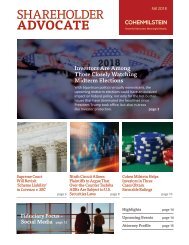Shareholder Advocate Spring 2018
You also want an ePaper? Increase the reach of your titles
YUMPU automatically turns print PDFs into web optimized ePapers that Google loves.
RECENT BRIEFS<br />
SECOND<br />
CIRCUIT<br />
ISSUES TRIO<br />
OF HELPFUL<br />
RULINGS<br />
BY ERIC S. BERELOVICH<br />
202.408.3666<br />
eberelovich@cohenmilstein.com<br />
V-CARD<br />
THE SECOND<br />
CIRCUIT NOW<br />
JOINS THE NINTH<br />
CIRCUIT IN<br />
REJECTING THE<br />
THIRD CIRCUIT’S<br />
HEIGHTENED<br />
STANDARD.<br />
In the last year, the U.S. Court of Appeals<br />
for the Second Circuit issued three<br />
important decisions in securities fraud<br />
actions that provide investors with greater<br />
clarity in satisfying the standards for class<br />
certification in the Second Circuit.<br />
In July 2017, the Second Circuit considered<br />
the standards for class certification in<br />
securities fraud cases involving overthe-counter<br />
securities traded in a global<br />
market in In re Petrobras Securities.<br />
Defendant Petrobras is a Brazilian<br />
company that lists its securities on both<br />
foreign and domestic exchanges, so class<br />
certification required consideration of the<br />
precedent set by the U.S. Supreme Court<br />
in Morrison v. Australian National Bank<br />
(“Morrison”). In Morrison, the Supreme<br />
Court held that U.S. securities laws apply<br />
only “to transactions in securities listed<br />
on domestic exchanges and domestic<br />
transactions in other securities.” In<br />
Petrobras, the defendants argued that<br />
it would be very difficult to identify<br />
which trades in Petrobras’s debt were<br />
domestic, and that a class consisting<br />
of “domestic transactions” thus could<br />
not be ascertained and, therefore, that<br />
the case should not be permitted to<br />
proceed as a class action. The Second<br />
Circuit’s opinion rejected defendants’<br />
argument and clarifies that the Circuit’s<br />
ascertainability requirement is met where<br />
the class is “defined using objective<br />
criteria that establish a membership<br />
with definite boundaries,” and that the<br />
criteria considered by the district court—<br />
subject matter, timing, and location—<br />
were “clearly objective” and it was thus<br />
“objectively possible” to ascertain which<br />
transactions were domestic. The Court<br />
noted that ascertainability does not<br />
require “a showing of administrative<br />
feasibility at the class certification stage,”<br />
and acknowledged that its holding on this<br />
point conflicts with the standard applied<br />
by the Third Circuit. The Second Circuit<br />
now joins the Ninth Circuit in rejecting the<br />
Third Circuit’s heightened standard. This is<br />
significant because a majority of securities<br />
fraud class actions are filed in the Second<br />
Circuit and Ninth Circuit. The circuit split<br />
signals that the Supreme Court may be<br />
inclined to address this matter in due<br />
course.<br />
Next, in November 2017, the Second<br />
Circuit in Waggoner v. Barclays PLC upheld<br />
a district court’s decision to certify a class<br />
of investors who sued Barclays for losses<br />
stemming from alleged misrepresentations<br />
it made regarding oversight of its so-called<br />
“dark pool” market. As is often the case,<br />
certification of the class turned on whether<br />
the plaintiffs had established that they<br />
relied on these alleged misrepresentations<br />
and omissions in buying the stock. The<br />
Supreme Court, in a rule known as the<br />
Basic presumption of reliance, permits<br />
reliance to be presumed in cases based<br />
upon fraudulent misrepresentations<br />
so long as the plaintiff satisfies certain<br />
requirements. At issue in Waggoner was<br />
the Basic presumption requirement that<br />
the stock at issue traded in an “efficient<br />
market,” that is, that the stock reacted to<br />
important publicly announced information<br />
about the company as reflected in stock<br />
price movement.<br />
COHENMILSTEIN.COM I 5



